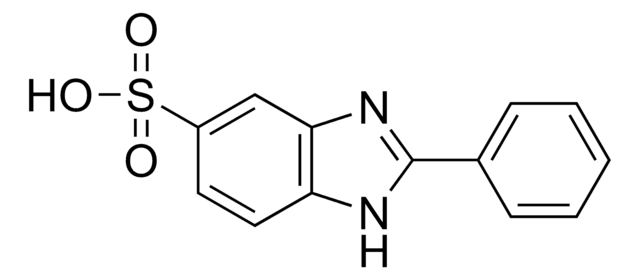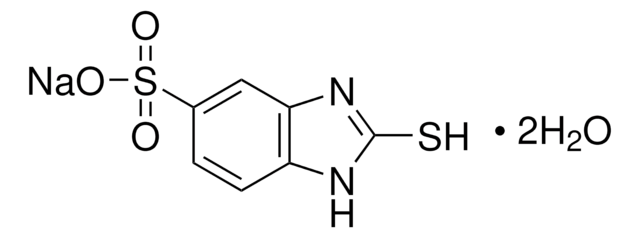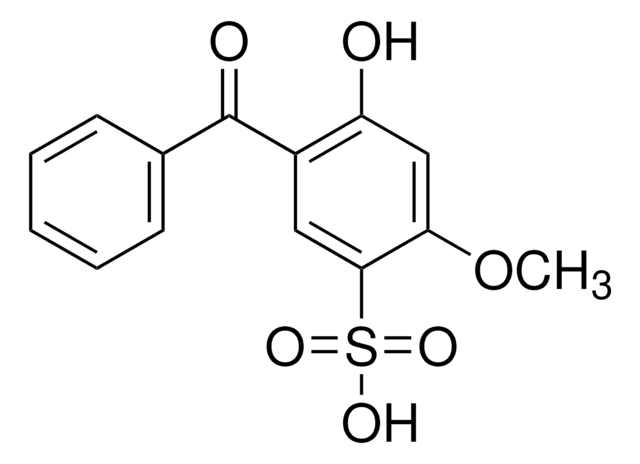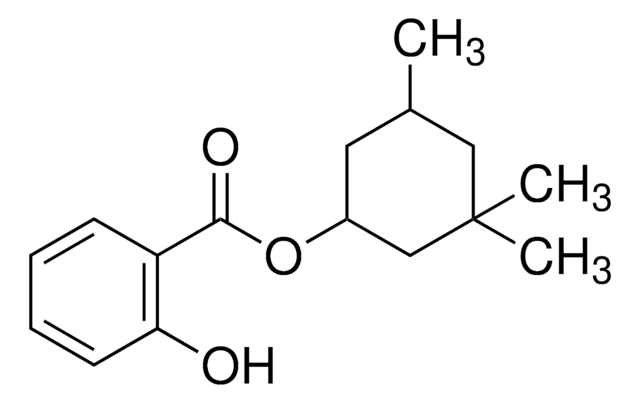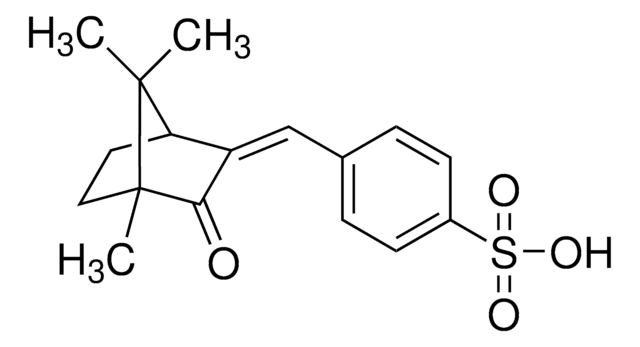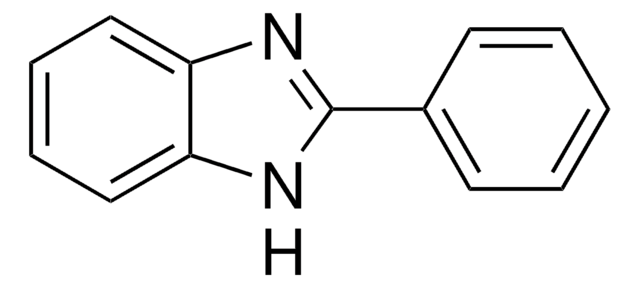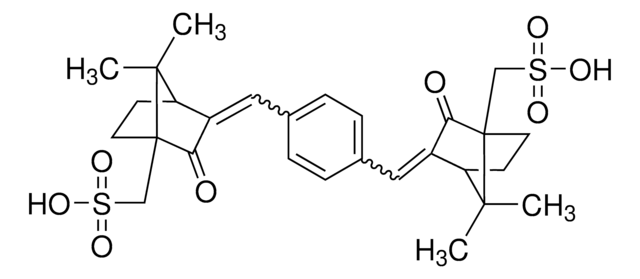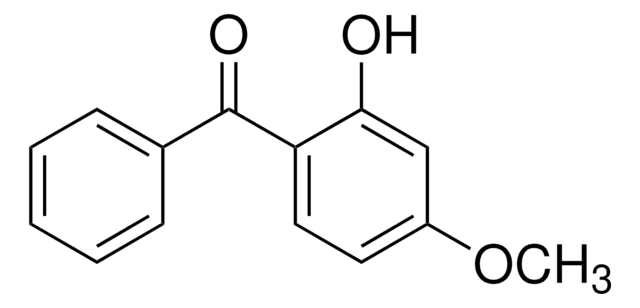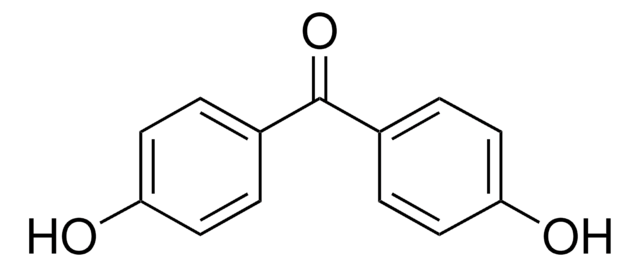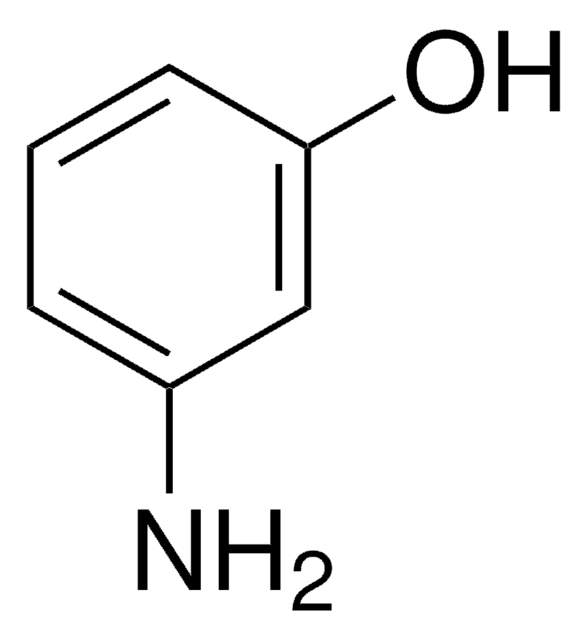437166
2-Phenyl-5-benzimidazolesulfonic acid
96%
Sinónimos:
Ensulizole
Iniciar sesiónpara Ver la Fijación de precios por contrato y de la organización
About This Item
Fórmula empírica (notación de Hill):
C13H10N2O3S
Número de CAS:
Peso molecular:
274.30
Número MDL:
Código UNSPSC:
12352100
ID de la sustancia en PubChem:
NACRES:
NA.22
Productos recomendados
Nivel de calidad
Ensayo
96%
mp
>300 °C (lit.)
solubilidad
ethanol and water: soluble (as sodium salt)
grupo funcional
phenyl
sulfonic acid
cadena SMILES
OS(=O)(=O)c1ccc2[nH]c(nc2c1)-c3ccccc3
InChI
1S/C13H10N2O3S/c16-19(17,18)10-6-7-11-12(8-10)15-13(14-11)9-4-2-1-3-5-9/h1-8H,(H,14,15)(H,16,17,18)
Clave InChI
UVCJGUGAGLDPAA-UHFFFAOYSA-N
¿Está buscando productos similares? Visita Guía de comparación de productos
Categorías relacionadas
Descripción general
2-Phenyl-5-benzimidazolesulfonic acid has been reported as UV filter. It is a xenobiotic compound detected in in gray water from houses and effluents of the biological treatment systems (aerobic, anaerobic, and combined anaerobic+aerobic). It is a micropollutant of personal care products and its removal from aerobically treated grey water by ozonation and adsorption onto activated carbon has been reported.
Aplicación
2-Phenyl-5-benzimidazolesulfonic acid was used for the fabrication of biomimetic sensor for determination of 4-methylbenzylidene camphor (4-MBC), an ultraviolet (UV) radiation protector.
UV absorber
Código de clase de almacenamiento
11 - Combustible Solids
Clase de riesgo para el agua (WGK)
WGK 1
Punto de inflamabilidad (°F)
Not applicable
Punto de inflamabilidad (°C)
Not applicable
Elija entre una de las versiones más recientes:
¿Ya tiene este producto?
Encuentre la documentación para los productos que ha comprado recientemente en la Biblioteca de documentos.
Los clientes también vieron
Lucía Hernández Leal et al.
Environmental science & technology, 44(17), 6835-6842 (2010-08-05)
Eighteen selected xenobiotics related to personal care and household chemicals (UV-filters, fragrances, preservatives, biocides, surfactants) were measured in gray water from 32 houses and in effluents of three different biological treatment systems (aerobic, anaerobic, and combined anaerobic+aerobic). All selected xenobiotics
Application of a biomimetic sensor based on iron phthalocyanine chloride: 4-methylbenzylidene-camphor detection.
Boni AC, et al.
Journal of the Brazilian Chemical Society, 21(7), 1377-1383 (2010)
L Hernández-Leal et al.
Water research, 45(9), 2887-2896 (2011-04-02)
Ozonation and adsorption onto activated carbon were tested for the removal micropollutants of personal care products from aerobically treated grey water. MilliQ water spiked with micropollutants (100-1600 μgL(-1)) was ozonated at a dosing rate of 1.22. In 45 min, this
Ashley R Heurung et al.
Dermatitis : contact, atopic, occupational, drug, 25(6), 289-326 (2014-11-11)
Sunscreen is a key component in the preventive measures recommended by dermatologists and public health campaigns aimed at reducing sunburn, early skin aging, and skin cancer. To maximize compliance, adverse reactions to sunscreens should be minimized. Although inactive ingredients cause
Murilo L Bello et al.
PloS one, 10(3), e0121110-e0121110 (2015-03-25)
Layered drug delivery carriers are current targets of nanotechnology studies since they are able to accommodate pharmacologically active substances and are effective at modulating drug release. Sodium montmorillonite (Na-MMT) is a clay that has suitable properties for developing new pharmaceutical
Nuestro equipo de científicos tiene experiencia en todas las áreas de investigación: Ciencias de la vida, Ciencia de los materiales, Síntesis química, Cromatografía, Analítica y muchas otras.
Póngase en contacto con el Servicio técnico